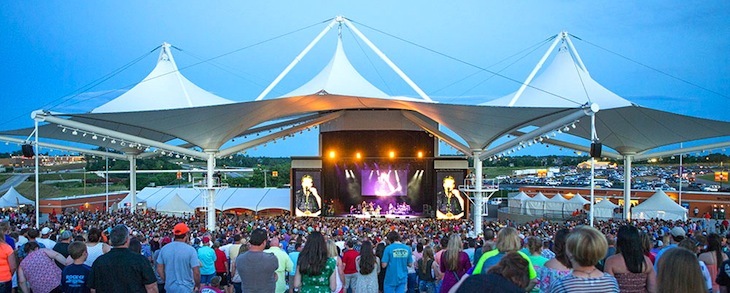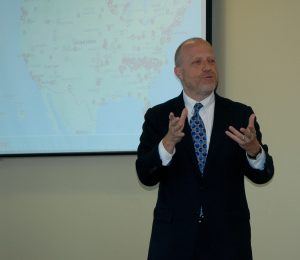Report: Arts had $131 million impact in Northwest Arkansas; an economic driver
by July 10, 2017 5:26 pm 2,342 views

The Walmart AMP in Northwest Arkansas.
Northwest Arkansas’ nonprofit arts and cultural events generated an estimated $131.2 million in economic activity in 2015, according to a new report from Americans for the Arts of Washington, D.C.
The report, part of the Arts & Economic Prosperity 5 project, attributes $67.5 million in direct spending by nonprofit arts and culture organizations in Benton and Washington counties and the remaining $63.7 million to event-related expenses made by their audiences, an estimated 1.8 million people that year, according to Americans for the Arts.
Twenty-three organizations from the two-county area provided information on their 2015 expenditures, and 822 attendees answered questions about how much they spent to attend the event, including everything from transportation, to lodging, to a meal before or afterward and the purchase of souvenirs. Admission costs were not counted.
Randy Cohen, vice president of research and policy for Americans and the Arts, presented the findings at a press conference on Monday (July 10) at World Trade Center Arkansas in Rogers. He said the arts act as an economic driver, in addition to providing “cultural benefits to the community.” This assertion is backed up, Cohen said, by a report released in April by the U.S. Bureau of Economic Analysis, which showed arts and cultural economic activity accounted for $730 billion in 2014, or 4.2% of the gross domestic product.
“We’re going to change the conversation about the arts a little bit, from one of charity to one of industry. The arts do not come as an expense of economic development. Rather, it’s an investment in an industry. One that supports jobs, generates government revenue and is the cornerstone of tourism,” Cohen said. “It’s big business.”
He pointed to a number of expenditures that could come up surrounding an event like a live performance and how those benefited different entities. Specifically, he looked at a recent night out with his wife, when expenses ranged from fees at a municipal parking lot, to the online purchase of a new necktie for the occasion and dinner out at a farm-to-table restaurant. On the organization side, Cohen said there can be expenses of which the audience is unaware, he said.
“These organizations employ more than just musicians and artists and curators and choreographers. They employ accountants, auditors, fundraisers, engineers, electricians and groundskeepers.”

Millions of dollars, for example, are spent for printing pamphlets, banners, programs and other materials for arts and culture organizations, Cohen added.
JOBS & REVENUE
Revenue generated to local government in Northwest Arkansas was $3.5 million, $1.3 million by the arts organization and $2.2 million by the attendee, according to Arts & Economic Prosperity. The report estimates that arts and culture activity supported 2,786 jobs through spending by the nonprofits and 1,861 through spending by attendees.
“The arts are not just food for soul. They’re putting food on the table for 4,647 people in the area,” Cohen said.
Household income generated through organizations for arts and culture events was $56 million, and income generated from attendees was $36.9 million, according to the report. Of the non-local attendees, 86% agreed with the statement: “This arts event is the primary purpose for my trip.”
“When we invest in the arts, we’re investing in a product that draws people into a community, and those people spend money,” Cohen said.
One in three attendees had an overnight stay, and overnight lodging costs for all non-residents was $25.35 per person.
Findings on resident and non-resident spending including the following.
• The average non-resident spent $27.28 per person on meals and refreshments. Residents spent $16.65.
• On souvenirs and gifts, non-residents spent $6.92 per person, versus $2.88 per person for residents.
• On ground transport, non-residents spent $8.86 per person, while residents spent $2.22.
The arts and culture are important not only in terms of tourism, but also in attracting and retaining talent, where quality of life is a key factor, Cohen said. “Young people, a new economy of workers, are picking the communities they want to live in,” rather than choosing the highest-paying job.
AVERAGE SPENDING INCREASES
Following are other findings in the report.
• Non-residents spent more than three times as much money surrounding arts and culture events than residents, at $71.20 per person, versus $23.85 spent by the average resident attending an event. Meanwhile, residents made up about three-fourths of attendees.
• The overall average spending per event attendee in NWA is $35.89, higher than the national average of $31.47 per person and 180% higher than the spending of NWA attendees in 2010, according to a previous Arts & Economic Prosperity report.
• The arts industry in Northwest Arkansas has grown significantly, due in large part to the addition of a permanent Walmart AMP in Rogers and the Crystal Bridges Museum of American Art in Bentonville between 2010 and 2015, according to a press release from the Walton Arts Center, the Americans for the Arts’ partner on the report. Total economic impact is up 124%, the number of jobs is up 212%, local and state revenue is up 248%, resident spending is up 50% and non-resident spending is up by 97%, according to the report.
Walton Arts Center President and CEO Peter Lane said the same study five years ago showed average expenditures to be $19 per person and $46 million total for NWA, representing a marked increase between then and now.
“It just speaks to the impact and growth of what arts and culture are doing in this region and as a driver of economic growth,” Lane said.
Nationally, about $5 billion was invested in nonprofit arts and culture events, and that industry generated an estimated $166.3 billion of economic activity during 2015, according to Americans for the Arts. Broken down, that’s $63.8 billion in spending by arts and cultural organizations and an additional $102.5 billion in event-related expenditures by their audiences.
This activity supported 4.6 million jobs and generated $27.5 billion in revenue to local, state and federal governments, according to the report.
